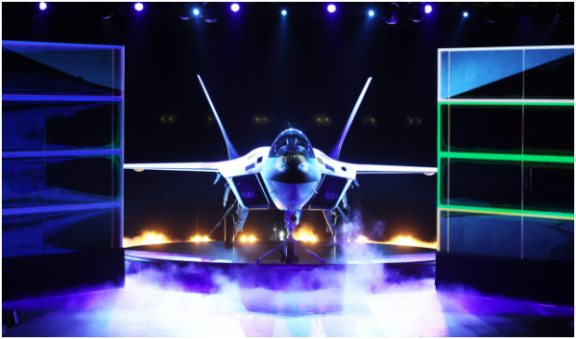South Korea Unveils Prototype of Homegrown Fighter Jet KF-21

The prototype of Korea’s homegrown fighter jet Boramae (KF-21) is rolled out at Korea Aerospace Industries in Sacheon-si, South Gyeongsang Province on April 9.
The prototype of Korea’s first homegrown fighter jet KF-21 has been officially unveiled.
Korea Aerospace Industries (KAI) and the Defense Acquisition Program Administration held a rollout ceremony for the prototype of the KF-21 in Sacheon, South Gyeongsang Province on April 9. The rollout ceremony is the first event to unveil a real fighter jet to the general public. The prototype was unveiled 20 years after the then President Kim Dae-jung mentioned the need to develop a Korean-type fighter jet in March 2001. The KF-21 has to undergo four years of ground and flight testing, which will start in July 2022. When the test is completed successfully, Korea will become the eighth country in the world to build a supersonic fighter jet with its own technology.
The KF-21 has the highest specifications among 4.5-generation fighter jets. The F-35 is a 5th-generation fighter jet. The Korean-type jet is 16.9 meters long, 4.7 meters tall and 11.2 meters wide, which means it is slightly larger than the U.S. F-16 (4th-generation) fighter jet. As its fuselage and wings are in a stealth shape, it takes after the F-22 (Raptor) Stealth Fighter. However, although it looks like a stealth airplane, it is not equipped with a stealth function. To avoid detection by enemy radars, a fighter jet should have its weapons inside its fuselage and wings. But the KF-21’s weapons are externally placed. KAI is planning to develop an inner hold for weapons such as missiles. Currently, it is not a stealth jet, but such a function could be added to it in the future.
The KF-21 has to pass many tests to take off and fly down the road. The first is a ground test, which will check the performance of its engine, active electronically scanned array (AESA) radar and integrated electronic warfare system for more than a year. The two prototypes of the KF-21unwrapped this time were designed exclusively for ground tests.
If the KF-21 passes the ground tests, it will face a flight test. The KF-21 is expected to fly for the first time in July next year. Over the next four years, it has to pass all 2,200 test flights. However, unexpected situations such as worsening weather conditions are variables. Therefore, KAI will increase the number of flights by mobilizing several prototypes. A total of six prototypes will be used for the flight test.
After passing the flight test, the KF-21 will take weapon tests for two years starting in 2026. It will have to verify its ability to use air-to-ground missiles and infrared navigation and tracking devices and an improvement will be made to the fighter jet based on the results of the test. Fourth, it will have to secure a stealth capability. It will have to have an engine, internal weapon holds, and paint suitable for stealth functions. Lastly, the government will further elevate the rate of localization which now stands at 65 percent. The development cost is expected to reach 8.8 trillion won. This is why this is the largest arms development project in Korean history. Including mass production of 120 units, the project will cost 18.6 trillion won in total.
The KF-21 development project has undergone seven feasibility studies. It took more than 10 years to finally embark on the project. The project cleared a big hurdle — the United States’ rejection to transfer core technologies such as those for AESA radars. An AESA radar is often compared to the eye of a fighter jet. The Agency for Defense Development and Hanwha System developed an AESA radar for the KF-21 on their own.
Hanwha Systems also developed an infrared search and track (IRST) system for the KF-21, too. An IRST system detects and tracks infrared signals from air-to-air targets. It also developed an electro-optical targeting pod (EO TGP) used to detect and track targets in the air and on the ground. LIG Nex1 developed integrated electronic warfare equipment that includes a radio frequency (RF) jammer. It is a device that detects enemy radar signals, disturbs them, and shoots flares. The localization rate of the AESA radar is 89 percent and that of the integrated electronic warfare equipment 77 percent. Hanwha Aerospace will push for the localization of the engine of the KF-21 dubbed the heart of the KF-21 after receiving related technology from General Electric (GE) in the United States.